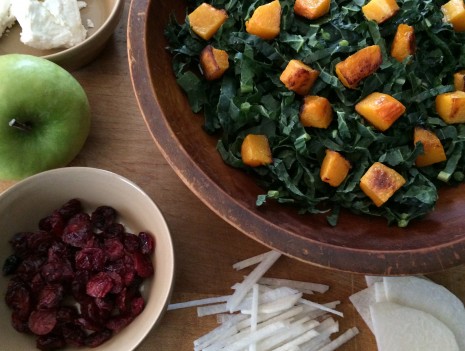A SALAD FOR A SNOWY NIGHT
The snow started earlier than predicted this morning, and soon settled in to enjoy itself. In a perfect world, I’d have lamb shanks braising in the oven, but since my time is not my own this week, roast chicken will do nicely. The kale and roasted squash salad I’ll serve with it is hearty enough to qualify as a side and requires practically no effort at all. It can also be pulled together on the fly, as evidenced by Katherine Redd, a longtime friend (36 years and counting) who’s been juggling work, overseeing construction in a new home and the subsequent move, and keeping body and soul together for husband and child. Life, in other words.
Recently she invited us over for an apartment viewing and nothing more complicated than take-out pizza, but I should have known she’d throw in a culinary flourish or two. “Doesn’t kale and roasted squash sound good together in a salad?” she asked. “With jicama, apple, and cheese. Goat or feta?” Fourteen-year-old Cornelia—my goddaughter—and I looked at each other and simultaneously voted for goat. Katherine started removing things from the fridge. “Oh, look, we have ginger. What about a little of that grated in the dressing?”
I wasn’t standing on ceremony, but poking into every cabinet and drawer. Katherine is on her fifth kitchen renovation, and her knack for optimizing every iota of space is ingenious; the woman could design yacht interiors. Her husband, Bill, blew in with plenty of wine and joie de vivre. And even though Katherine was surrounded by unpacked boxes, she unerringly pointed out the one that contained the corkscrew. We were in business.
Katherine based her salad on one she’d had at the Candle Cafe, an ahead-of-its-time (since 1994) vegan restaurant so cozy and inviting that carnivores don’t miss the meat. Or goat cheese. But the beauty of the salad lies in its ease and versatility. You can keep prep time to a minimum, for instance, by buying baby kale and cubed winter squash. For food safety reasons, give the kale a rinse (even if it’s labeled “triple-washed”), and if the cubes of squash are fairly large, cut them into smaller pieces for quicker cooking.
Even if you are starting from scratch, so to speak—with a whole butternut, say, and a bunch of kale—the prep isn’t especially onerous or time-consuming. Get the squash in the oven first, of course. It helps if your butternut has a long neck in proportion to the bulbous base; when you see how efficiently my former Gourmet colleague Kempy Minifie deals with peeling it (and using it in a favorite weeknight recipe), it will change your life. If you are really pressed for time or want a lighter, more delicate dish, then forgo the roasting and go with paper-thin shavings of uncooked squash. And consider branching out from butternut; two other winter squashes I’m very fond of are sweet bonbon and red kuri, which is chestnutty in flavor.
As far as the kale goes, if you can find the variety called lacinato, with its green-black leaves, pounce. The signature ingredient in any self-respecting minestrone, it’s a breeze to work with since there’s generally no need to strip out the stems and center ribs: They’re usually tender enough to eat, even when raw. The trick is to slice the leaves into thin ribbons, and the fastest way to do that is to stack a few (washed) leaves, then roll them up like a cigar. Cut the cigar crosswise into thin pieces and before you know it, you are D-O-N-E, done.
You need something crisp and fresh-tasting to offset the richness of the roasted veg and the meatiness of the kale, and this is where things start to get really interesting. Matchsticks of crisp, juicy, sweet jicama (hee-ka-ma) are just the ticket, but kohlrabi or celery root would be delicious, too. An apple, also cut into matchsticks, brings tartness to the party, and chunks of creamy goat cheese add a different sort of tang.
Katherine plumped a handful of raisins in a warm garlicky vinaigrette before dressing the salad, and I was all set to follow her lead until I realized we were 1) out of raisins, and 2) out of garlic. I do not understand how this happened, but never mind. As I said earlier, this salad is versatile. I could see it working with a maple or sherry vinaigrette, but I ended up just supplementing the olive oil in a very basic dressing with some of the drippings (and flavorful brown crunchy bits) from the roast chicken and a handful of dried cranberries that’s been kicking around since Christmas.
The muffled thumps at the door meant Sam was home and kicking off his Bean boots. A minute later, he padded into the kitchen in his socks and surveyed the situation. “You said salad for supper, but I didn’t know you meant this,” he said. “Dinner is going to be good.”
Salad Dressing with Roast-Chicken Drippings
1/3 cup mild extra-virgin olive oil
2 tablespoons fresh lemon juice
Drippings (including some brown crunchy bits) from a roast chicken
Coarse salt and freshly ground pepper
Whisk the olive oil into the lemon juice, then whisk in drippings to taste. Season with salt and pepper.
Posted: January 21st, 2014 under cooking, Gourmet magazine, people + places, recipes, restaurants.



